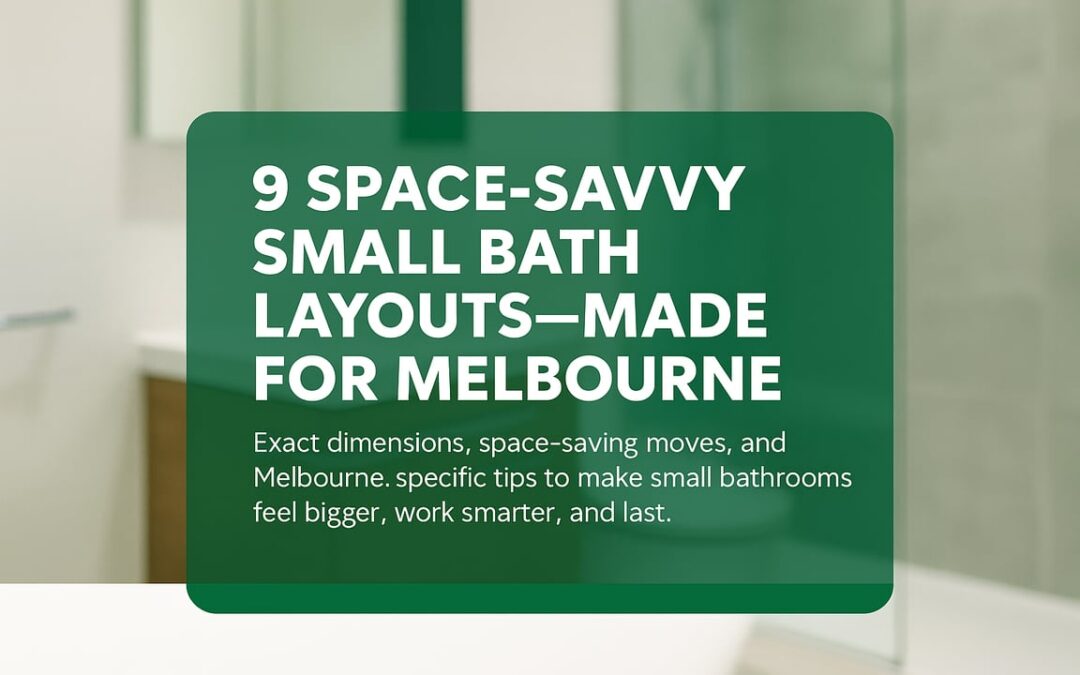Small Bathroom Layout Melbourne: 9 Space-Savvy Plans That Feel Bigger, Work Smarter, and Last
Melbourne homes often squeeze bathrooms into tight footprints, from inner-terrace ensuites to compact apartments. This guide shares practical layouts, clear dimensions, and finish choices that make small rooms feel larger and function better. A single, relevant link is included for readers comparing small bathroom layout Melbourne options and coordinated renovation support.
Before You Move Walls: Measure, Map, and Prioritise Flow
- Measure the room shell: length, width, ceiling height, and door/window positions. Note wall thicknesses in period homes.
- Map services: existing waste locations, water points, and ventilation path. Timber subfloors are typically easier to re-route than slabs.
- Protect circulation: aim for an 800 mm clear path (700 mm in tight rooms with careful detailing). Doors that swing out or pocket sliders save space.
- Sequence decisions: layout first, fixtures next, finishes last. This prevents costly rework.
9 Proven Small-Bathroom Layouts That Work in Melbourne
1) Single-Wall Straight Run
All services on one wall to control cost and keep a clean sightline. Best for narrow terraces and apartments.
- Typical order: door entry, vanity, toilet, shower at the end behind frameless glass.
- Target sizes: 1500 to 1800 mm width x 2200 to 2600 mm length.
- Benefit: fast install, fewer penetrations, stronger waterproofing continuity.
2) Galley Two-Wall
Fixtures split across opposing walls. Good in rooms around 1800 to 2000 mm wide.
- Place vanity opposite shower to avoid knee clashes with the toilet.
- Use a sliding or pocket door to preserve aisle width.
3) L-Shape Corner
Places the shower or toilet on the short return to free a longer wall for vanity and storage.
- Works well where a nib wall or privacy wing can be added.
- Ideal for ensuites tucked off bedrooms with limited openings.
4) Compact Wet Room
Continuous floor and drain area with level-entry shower. Excellent for micro spaces and accessibility.
- Requires certified waterproofing and correct falls to drain.
- Choose slip-rated floor tiles and keep grout joints consistent.
5) Niche Shower With Inline Vanity
Recess the shower into the end of the room; run a slim, long vanity along the wall.
- Great for natural light at the far wall; use clear glass to borrow light.
- Consider a 400 to 430 mm deep vanity for a narrow aisle.
6) Corner Entry Shower + Wall-Hung Toilet
Diagonal or corner shower entry opens walking space and reduces door clashes.
- Wall-hung toilet and vanity create visual floor continuity for a larger feel.
- Plan in-wall cistern access panels for maintenance.
7) Three-Wall Luxe (Small-Scale)
Toilet, vanity, and shower each on separate walls for premium function in a compact footprint.
- Best executed where services can be economically re-routed (timber subfloor).
- Use a linear drain to keep floor planes simple.
8) Bath-Shower Combo Done Right
Where a bath is essential, pair it with a frameless panel and rail for a safer, cleaner combo.
- Prioritise a slightly wider bath ledge for safer entry/exit.
- Full-height tiling helps moisture control.
9) Laundry-Combo Ensuite
Stacked washer/dryer concealed behind bifolds opposite a slim vanity in small apartments.
- Acoustic and ventilation planning is critical.
- Use pocket or cavity sliders to keep clearances.
Dimensions That Prevent Regret
- Toilet clearance: 750 mm minimum width zone; 600 mm clear in front.
- Shower internal: 900 x 900 mm is comfortable; 1000 x 1000 mm feels generous. 850 x 900 mm can work with frameless glass and smart drainage.
- Vanity depth: 400 to 430 mm for narrow rooms; 450 to 500 mm standard small bath; 600 mm for main baths where space permits.
- Basin height: 850 to 900 mm benchtop; vessel sinks may sit lower overall to maintain comfortable lip height.
- Door swings: ensure 100 mm clearance to fixtures or choose cavity sliders.
Space Multipliers That Visually Enlarge the Room
- Wall-hung elements: vanities and toilets reveal more floor, reducing visual clutter.
- Large-format porcelain: 600 x 1200 mm or larger on walls reduces grout grid. Level substrates are essential.
- Continuous floors: color-matched floor tile through the shower line with linear drains.
- Mirrors and shaving cabinets: recess where possible; align with grout lines for a tailored look.
- Glass choices: low-iron, frameless screens keep sightlines clear; avoid heavy frames in small rooms.
- Light layering: task lights at face height, soft ceiling ambient, and a night-light path.
Moisture Management, Ventilation, and Durability
- Waterproofing: certified membranes with full upturns, sealed penetrations, and movement joints at changes of plane.
- Ventilation: externally ducted exhaust sized to room and shower volume; consider run-on timers.
- Slip resistance: select appropriate slip-rated floor tiles, especially for wet-room formats.
- Cabinetry: moisture-resistant substrates with sealed edges; corrosion-resistant hardware.
- Sealants: silicone at all junctions where movement is expected; epoxy or premium grouts in high-wet zones to reduce staining.
Melbourne-Specific Tips
- Timber subfloors: often allow waste relocation with less disruption; check joist direction before final layout.
- Slab-on-ground: favor in-place layouts where possible; plan saw cuts and reinstatement carefully when moving wastes.
- Inner-terrace constraints: pocket doors, wall-hung fixtures, and wet-room detailing reduce pinch points.
- Apartments: strata approvals, acoustic underlays, and service stack limits should be confirmed early.
Fixture and Finish Shortlist for Small Rooms
- Thin-edged basins and compact mixers to save depth.
- Shower rails with adjustable heads to suit multiple users.
- Clear glass shelves or recessed niches to keep benches free.
- Porcelain or sintered stone tops for durability and easy cleaning.
- Matt or soft-sheen wall tiles to reduce glare; glossy tiles used thoughtfully where reflections help.
Budget-Savvy Moves That Do Not Feel Like Compromise
- Keep plumbing broadly in the same zone; invest in a level-entry shower and quality exhaust.
- Use a single hero tile as a feature and pair with a budget field tile.
- Choose a standard-size vanity carcass with custom depth tweaks only where needed.
- Stage for the future: reinforce walls now for later grab rails or accessories.
When Professional Help Pays Off
Coordinated teams reduce disruption and keep layout, waterproofing, cabinetry, and tiling aligned. A managed renovation pathway helps maintain timelines, finish quality, and compliance while protecting the layout logic that makes small rooms live larger.
Mini Checklists
Compact Ensuite
- Target 700 to 800 mm clear path.
- Wall-hung vanity 400 to 430 mm deep.
- 900 x 900 mm shower with linear drain and frameless panel.
- Recessed mirror cabinet and pocket door.
Main Family Bathroom (Small)
- Maintain 800 mm aisle where possible.
- Double-drawer vanity for storage; add tall, slim tower out of the splash zone.
- Bath-shower combo with safety ledge if a bath is essential.
- Externally ducted exhaust and night-light path.
Future-Friendly Upgrade
- Reinforce walls for future grab rails.
- Level-entry shower and slip-rated floor tiles.
- Lever mixers and easy-grip hardware.
- Lighting on separate circuits for flexibility.
Related Service Note
For homeowners who prefer a coordinated, end-to-end approach that blends design, layout optimization, tiling, and finishing, Melbourne specialists can plan and deliver small-space renovations that look good and work day to day.
FAQ
What is a realistic budget range for a small bathroom in Melbourne?
Budgets vary with scope and room condition. Cosmetic refreshes typically sit at the lower end, while full waterproofing, layout shifts, and premium finishes trend higher. Quotes should itemise waterproofing, tiling areas, fixture allowances, and ventilation.
Is a separate bath and shower realistic in a small room?
It can be, but trade-offs arise. A bath-shower combo or a generous shower with a future bath in another zone often improves day-to-day function and safety.
Which layout suits a narrow terrace bathroom?
Single-wall or galley layouts with a frameless end shower and a wall-hung vanity usually protect circulation and light.
Do large-format tiles work in small bathrooms?
Yes, provided substrates are flat and set-out is planned. Fewer grout lines visually expand the room; use appropriate slip ratings on floors.
How important is ventilation in small bathrooms?
Critical. Externally ducted exhaust with adequate flow and run-on timers helps manage moisture, protect finishes, and reduce mould risk.

